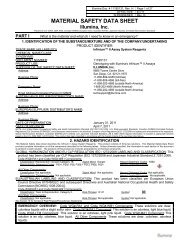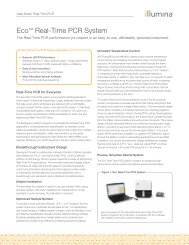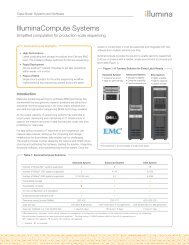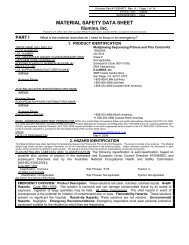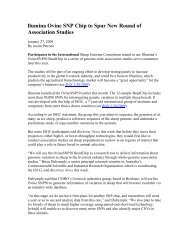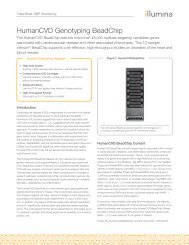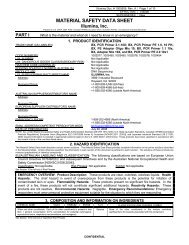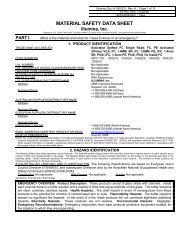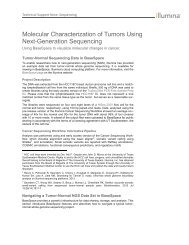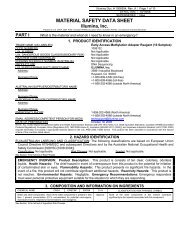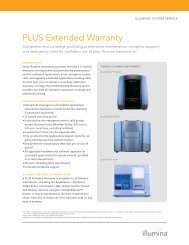Use of High and Low- Density SNP Genotypes in Genomic ... - Illumina
Use of High and Low- Density SNP Genotypes in Genomic ... - Illumina
Use of High and Low- Density SNP Genotypes in Genomic ... - Illumina
Create successful ePaper yourself
Turn your PDF publications into a flip-book with our unique Google optimized e-Paper software.
<strong>Use</strong> <strong>of</strong> <strong>High</strong> <strong>and</strong> <strong>Low</strong>-<br />
<strong>Density</strong> <strong>SNP</strong> <strong>Genotypes</strong> <strong>in</strong><br />
<strong>Genomic</strong> Selection <strong>and</strong> QTL<br />
Discovery <strong>in</strong> Dairy Cattle<br />
Kent A. Weigel, Ph.D.<br />
Department <strong>of</strong> Dairy Science<br />
University <strong>of</strong> Wiscons<strong>in</strong>
Cattle Genome Sequence<br />
<br />
AGTCCATGGGGTTGCAGAGTCAGACACAGTGGAGTCACACACATACACACG<br />
GCCCCACGCTGGGTTAAGGCGGGGCTGAGACAAGGGCAGGTGAGGCCTCCCA<br />
• 30 pairs <strong>of</strong> chromosome pairs (<strong>in</strong>cl. X,Y)<br />
• 3 billion base pairs
Illum<strong>in</strong>a Bov<strong>in</strong>e<strong>SNP</strong>50<br />
Genotyp<strong>in</strong>g BeadChip<br />
~ $225 per animal today
Dairy Cattle Genotyp<strong>in</strong>g<br />
(as <strong>of</strong> January 2009)<br />
Countries<br />
Source: USDA-ARS<br />
Animals<br />
United States <strong>and</strong> Canada 22,344<br />
France 8,500<br />
Netherl<strong>and</strong>s, New Zeal<strong>and</strong> 1 6,000<br />
New Zeal<strong>and</strong> <strong>and</strong> Irel<strong>and</strong> 4,500<br />
Germany 3,000<br />
Australia 2,000<br />
Denmark, F<strong>in</strong>l<strong>and</strong>, Sweden 2,000
CDDR Contributors<br />
(Cooperative Dairy DNA Repository)
Source: USDA-ARS<br />
<strong>SNP</strong> Genotype <strong>of</strong> Elevation<br />
(chromosome 1)<br />
1000111220020012111011112111101111001121100020122002220111<br />
1202101200211122110021112001111001011011010220011002201101<br />
1200201101020222121122102010011100011220221222112021120120<br />
2010020220200002110001120201122111211102201111000021220200<br />
0221012020002211220111012100111211102112110020102100022000<br />
2201000201100002202211022112101121110122220012112122200200<br />
0200202020122211002222222002212111121002111120011011101120<br />
0202220001112011010211121211102022100211201211001111102111<br />
2110211122000101101110202200221110102011121111011202102102<br />
1211011022122001211011211012022011002220021002110001110021<br />
1021101110002220020221212110002220102002222121221121112002<br />
0110202001222222112212021211210110012110110200220002001002<br />
0001111011001211021212111201010121202210101011111021102112<br />
2111111212111210110120011111021111011111220121012121101022<br />
202021211222120222002121210121210201100111222121101
<strong>SNP</strong> Effects for Milk Yield<br />
O’Connell, 2008
Source: USDA-ARS (O’Connell)<br />
<strong>SNP</strong> Effects for Net Merit
What is a <strong>Genomic</strong> PTA?<br />
• Approximately 40,000 genetic markers<br />
(<strong>SNP</strong>s) are evaluated<br />
• For each <strong>SNP</strong>, the difference <strong>in</strong><br />
predicted transmitt<strong>in</strong>g ability (PTA)<br />
between animals with 0, 1, or 2 copies<br />
<strong>of</strong> a specific allele is estimated<br />
• <strong>Genomic</strong> evaluations comb<strong>in</strong>e <strong>SNP</strong><br />
effect estimates with the exist<strong>in</strong>g<br />
parent average (PA) or PTA for each<br />
animal
Source: USDA-ARS (VanRaden)<br />
Validation Study<br />
(2004 data were used to predict 2009 data)<br />
HOL JER BSW<br />
Predictor:<br />
Bulls born 2000 2,035 388 150
Source: USDA-ARS (VanRaden)<br />
Reliability Ga<strong>in</strong>s by Trait<br />
(ga<strong>in</strong> above parent average reliability ~35%)<br />
HOL JER BSW<br />
Lifetime Net Merit 24% 8% 9%<br />
Milk Yield 26% 6% 17%<br />
Fat Yield 32% 11% 10%<br />
Prote<strong>in</strong> Yield 24% 2% 14%<br />
Fat % 50% 36% 8%<br />
Prote<strong>in</strong> % 38% 29% 10%
Source: USDA-ARS (VanRaden)<br />
Reliability Ga<strong>in</strong>s by Trait<br />
(ga<strong>in</strong> above parent average reliability ~35%)<br />
HOL JER BSW<br />
Productive Life 32% 7% 12%<br />
Somatic Cell Score 23% 3% 17%<br />
Daughter Pregnancy Rate 28% 7% 18%<br />
F<strong>in</strong>al Score 20% 2% 5%<br />
Udder Depth 37% 20% 8%<br />
Foot Angle 25% 11% (1%)
Source: USDA-ARS (VanRaden)<br />
Reliabilities for Young Bulls<br />
Parent Average vs. <strong>Genomic</strong> PTA
Source: USDA-ARS<br />
Adoption <strong>of</strong> <strong>Genomic</strong> Test<strong>in</strong>g<br />
(young bulls <strong>in</strong> US AI studs, April 2009)<br />
Birth<br />
Year<br />
No. Bulls<br />
Sampled<br />
No. Bulls<br />
Tested<br />
Percent<br />
Tested<br />
2008* 649 615 95%<br />
2007* 1548 1172 76%<br />
2006 1726 1118 65%<br />
2005 1677 1217 73%<br />
2004 1655 991 60%<br />
*count for birth year is <strong>in</strong>complete
<strong>Low</strong>-Cost Genotyp<strong>in</strong>g Assays<br />
• At the current price, the Bov<strong>in</strong>e<strong>SNP</strong>50<br />
BeadChip is limited to applications<br />
<strong>in</strong>volv<strong>in</strong>g males <strong>and</strong> elite females<br />
• An with 300-1000 selected <strong>SNP</strong>s might<br />
deliver a substantial portion <strong>of</strong> the ga<strong>in</strong><br />
for a fraction <strong>of</strong> the price<br />
• Applications may <strong>in</strong>clude: parentage<br />
discovery, selection <strong>of</strong> replacement<br />
heifers, prelim<strong>in</strong>ary screen<strong>in</strong>g <strong>of</strong> young<br />
bulls, <strong>and</strong> genomic mat<strong>in</strong>g programs
Which <strong>SNP</strong>s to Select?<br />
Pick the <strong>SNP</strong>s with largest estimated effects?<br />
How many do we need?
Which <strong>SNP</strong>s to Select?<br />
Pick evenly spaced <strong>SNP</strong>s?<br />
How many do we need?
Validation <strong>of</strong> <strong>Low</strong>-<strong>Density</strong><br />
<strong>Genomic</strong> PTAs<br />
• Compute parent averages <strong>and</strong> genomic<br />
PTAs us<strong>in</strong>g 2003 data from 3,305<br />
Holste<strong>in</strong> bulls born <strong>in</strong> 1952-1998<br />
“Tra<strong>in</strong><strong>in</strong>g Set”<br />
• Compare ability to predict daughter<br />
deviations <strong>in</strong> 2008 data for 1,398 bulls<br />
born from 1999-2002<br />
“Test<strong>in</strong>g Set”
PTA from Progeny Test<strong>in</strong>g (gen. SD)<br />
Predictive Ability for Net Merit<br />
(<strong>Genomic</strong> PTA vs. Progeny Test PTA <strong>in</strong> Test<strong>in</strong>g Set)<br />
Correlation = 0.61<br />
32,518 <strong>SNP</strong>s<br />
Predicted <strong>Genomic</strong> PTA from All <strong>SNP</strong>s
Predictive Ability for Net Merit<br />
(<strong>Genomic</strong> PTA from <strong>SNP</strong>s vs. Progeny Test PTA <strong>in</strong> Test<strong>in</strong>g Set)<br />
Correlation = 0.43 Correlation = 0.52<br />
PTA from Progeny Test<strong>in</strong>g<br />
300 <strong>SNP</strong>s<br />
Correlation = 0.55 Correlation = 0.57<br />
750 <strong>SNP</strong>s<br />
1250 <strong>SNP</strong>s<br />
2000 <strong>SNP</strong>s<br />
Predicted <strong>Genomic</strong> PTA from Top ___ <strong>SNP</strong>s
Animal ID Applications<br />
(96+ <strong>SNP</strong>s <strong>in</strong> the parentage panel)<br />
• Verify reported parents<br />
• Discover parents if unknown or <strong>in</strong>correct<br />
• Trace animals or animal products
Close Inbreed<strong>in</strong>g (F=14.7%)<br />
Double Gr<strong>and</strong>son <strong>of</strong> Aerostar<br />
(Chromosome 24)<br />
Aerostar<br />
Megastar<br />
Aerostar<br />
VanRaden, 2008
<strong>SNP</strong> Genotype <strong>of</strong> Megastar<br />
(chromosome 24)<br />
1021222101021021011102110112112211211002202000222020002020220<br />
0000220020222202202000020020222222000020222200000220200002002<br />
2002000000222200022220000000000020222022002000222020222220002<br />
2022222222200002002202022202000200022000000002202220000002200<br />
2020002222002020020020202220222222220222020002022022022220202<br />
2202020202200022002220220022200000220200002002002000200222220<br />
0022220202002220022202000020200000022222020200002002002222000<br />
2022022220022000222202200222202020002202202222002220022000200<br />
2202000002200220222000022000022000222202002222000220020020202<br />
2020002220002220022202202200000220220020020020220002000222202<br />
2002220020220200222202220000020220002020020202000220022000002<br />
2022200202220200022002000200022002002000200220222220022022000<br />
2000020002000020220020220200200002220000222002000200222000022<br />
0220020022002202202020202020200022202000220200202202220220000<br />
2020200002020200022222200222200020022022220000020220020200202<br />
022022020200002000200220220002200
Effects on Inbreed<strong>in</strong>g<br />
• Traditional animal model evaluations<br />
favor co-selection <strong>of</strong> families or relatives<br />
• <strong>Genomic</strong> selection allows with<strong>in</strong>-family<br />
selection, which leads to less <strong>in</strong>breed<strong>in</strong>g<br />
• <strong>Low</strong>-cost, low-density genotyp<strong>in</strong>g<br />
assays will allow widespread screen<strong>in</strong>g <strong>of</strong><br />
families that might provide unique genetic<br />
contributions to the population<br />
• Identification <strong>and</strong> control <strong>of</strong> <strong>in</strong>herited<br />
defects will be greatly enhanced as well
Potential for Mate Selection<br />
• Millions <strong>of</strong> cows are mated us<strong>in</strong>g<br />
computerized programs each year, based<br />
on faults <strong>in</strong> conformation or avoidance <strong>of</strong><br />
<strong>in</strong>breed<strong>in</strong>g<br />
• <strong>SNP</strong> genotypes <strong>of</strong> AI sires <strong>and</strong><br />
potential mates could be used to m<strong>in</strong>imize<br />
<strong>in</strong>breed<strong>in</strong>g or to identify parents with<br />
“complementary” DNA pr<strong>of</strong>iles<br />
NM$<br />
80<br />
60<br />
40<br />
20<br />
0<br />
-20<br />
-40<br />
X 2 4 6 8 10 12 14 16 18 20 22 24 26 28 30<br />
Chromosome<br />
NM$
NM$<br />
80<br />
60<br />
40<br />
20<br />
0<br />
-20<br />
-40<br />
Net Merit by Chromosome<br />
7HO6417 O Man<br />
X 2 4 6 8 10 12 14 16 18 20 22 24 26 28 30<br />
Chromosome<br />
NM$<br />
VanRaden, 2008
Net Merit by Chromosome<br />
7HO8081 Planet<br />
100<br />
80<br />
NM$<br />
60<br />
NM$<br />
40<br />
20<br />
0<br />
-20<br />
X 2 4 6 8 10 12 14 16 18 20 22 24 26 28 30<br />
Chromosome<br />
VanRaden, 2008
Possibilities for Novel Traits<br />
• Opportunities to collect DNA <strong>and</strong><br />
phenotypes for traits not rout<strong>in</strong>ely<br />
assessed <strong>in</strong> national record<strong>in</strong>g schemes<br />
• Examples <strong>in</strong>clude: feed <strong>in</strong>take, hormone<br />
level, immune function, ho<strong>of</strong> care, etc.<br />
• Potential resource populations <strong>in</strong>clude:<br />
experimental herds, calf ranches, heifer<br />
growers, commercial herds with specific<br />
milk<strong>in</strong>g/feed<strong>in</strong>g/management equipment,<br />
veter<strong>in</strong>ary databases (without sire ID)
Novel Traits <strong>and</strong> <strong>Genomic</strong>s<br />
additive or<br />
non-additive<br />
<strong>in</strong>heritance<br />
no selection<br />
bias<br />
update estimates<br />
<strong>of</strong> <strong>SNP</strong> effects<br />
Recorded<br />
Population<br />
(10,000-25,000 animals<br />
per trait or trait group)<br />
full<br />
genotyp<strong>in</strong>g<br />
selective<br />
genotyp<strong>in</strong>g<br />
ref<strong>in</strong>e estimates<br />
<strong>of</strong> location <strong>and</strong><br />
effect, add <strong>SNP</strong>s<br />
$200/genotype<br />
$100/trait<br />
5 traits/group<br />
select high/low 10%<br />
Whole<br />
Genome<br />
Selection<br />
cost ~ $7.0-17.5 mln<br />
per trait group<br />
GWAS to<br />
detect QTL,<br />
then MAS<br />
cost ~ $1.2-3.0 mln<br />
per trait
Synergy with Herd Management<br />
• “Personalized medic<strong>in</strong>e” is a key<br />
objective <strong>of</strong> biomedical research<br />
• Examples <strong>in</strong>clude genotype-guided<br />
Warfar<strong>in</strong> dos<strong>in</strong>g us<strong>in</strong>g two major genes<br />
• Cost-effective applications <strong>in</strong> livestock<br />
will <strong>in</strong>volve a series <strong>of</strong> small returns from<br />
enhanced vacc<strong>in</strong>ation programs, ration<br />
formulation, mate selection, veter<strong>in</strong>ary<br />
care, <strong>and</strong> animal group<strong>in</strong>g decisions<br />
• Integration with herd management<br />
s<strong>of</strong>tware will be the key to success
http://www.wisc.edu/dysci<br />
UW-Madison Dairy Science…Committed to<br />
Excellence <strong>in</strong> Research, Extension <strong>and</strong> Instruction<br />
Any<br />
Questions?



